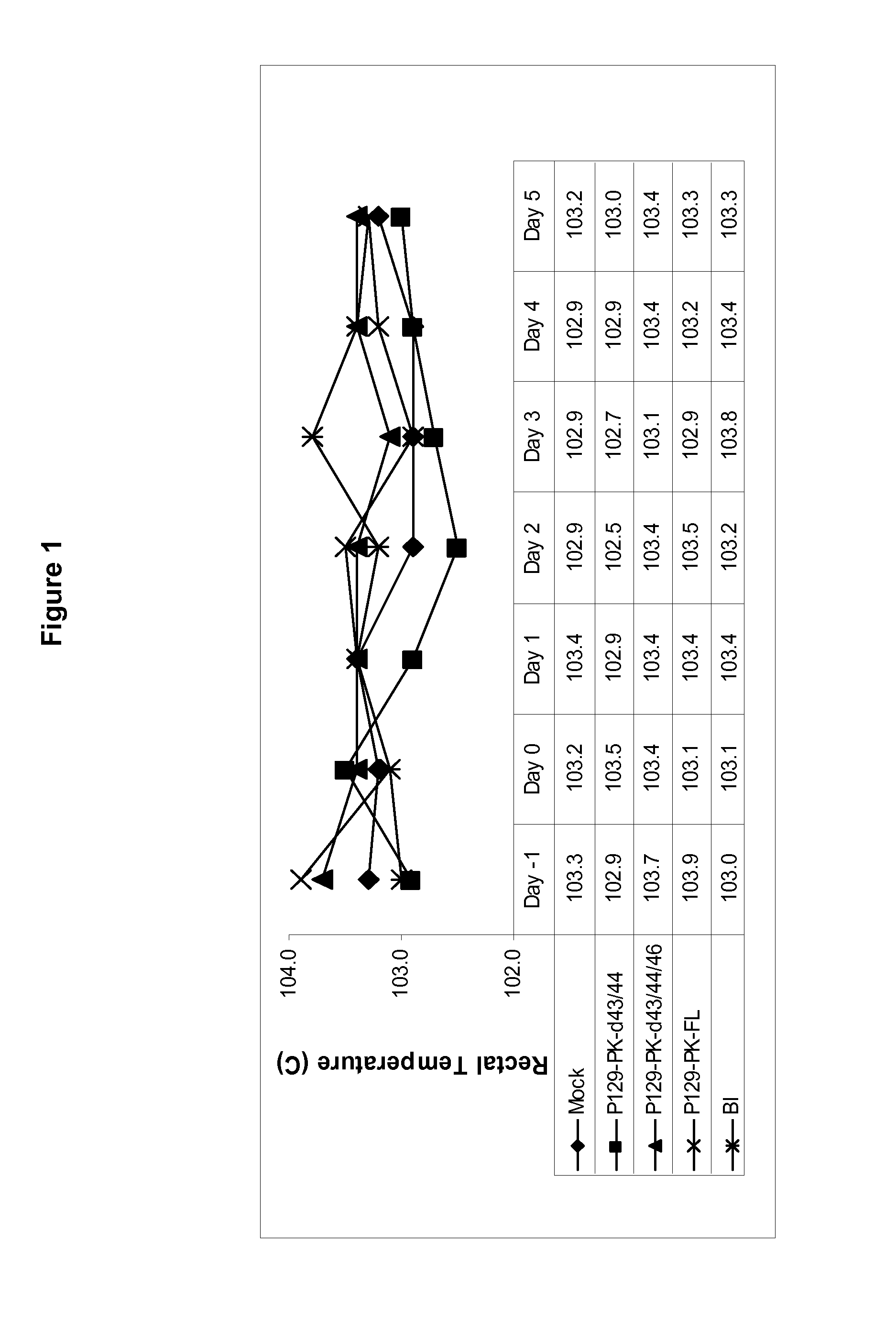Effective vaccination against porcine reproductive and respiratory syndrome (PRRS) virus prior to weaning
a technology of reproductive and respiratory syndrome and vaccination campaign, which is applied in the field of effective vaccination against porcine reproductive and respiratory syndrome (prrs) virus prior to weaning, can solve the problems of ineffective vaccination campaign, inability to control the disease, and difficulty in controlling the virus, so as to reduce the effect of interferon- inhibitory
- Summary
- Abstract
- Description
- Claims
- Application Information
AI Technical Summary
Benefits of technology
Problems solved by technology
Method used
Image
Examples
example 1
Adaptation and Attenuation of Prrsv Isolate P129 to Pk-9 Cells
[0126]Virulent PRRS isolate P129 was isolated from a sick pig in Indiana in 1995 at the Animal Disease Diagnostic Laboratory of Purdue University. A serum sample from this pig was passaged once in a high health status pig to expand serum and lung homogenate stocks. Viral RNA was extracted from the serum and lung homogenate and used to determine the complete genome consensus sequence of P129 passage 0 virus. RNA was first primed with random hexamers and used to synthesize cDNA. The genome was amplified in three overlapping pieces using high fidelity (proofreading) PCR. The PCR products from three separate PCR reactions (per genome segment) were T / A cloned and used for DNA sequencing to generate a full length genome consensus sequence (see SEQ ID NO:1).
[0127]An aliquot of the same pig serum used for DNA sequencing, containing P129 passage 0, was used to infect primary porcine alveolar macrophage (PAM) cells. The progeny vir...
example 2
Construction of an Infectious cDNA Clone of P129-PK Passage 17
[0130]An infectious cDNA clone of the P129-PK passage 17 virus was constructed, using a backbone plasmid as previously described. The genome of the virus was amplified by reverse transcription and PCR in three overlapping segments, with naturally occurring unique restriction endonuclease sites in the regions of overlap. The products from three separate PCR reactions were cloned and sequenced, and aligned to generate a consensus sequence for each genome segment. If none of the three cloned products of a given segment matched the predicted amino acid sequence of the consensus for that segment, one of the clones was modified by subcloning and / or site-directed mutagenesis until it matched the predicted amino acid sequence of the consensus. The three genome segments and the plasmid backbone were joined using standard cloning techniques and restriction endonuclease sites. The resulting full-length clone, designated pCMV-S-P129-...
example 3
Deletion Mutants in P129-PK Passage 17
[0132]Deletions in two areas of the genome were engineered into infectious cDNA clone pCMV-S-P129-PK17-FL, to generate five genetically modified infectious clones.
[0133]One area of the genome to undergo modification was the nuclear localization sequence (NLS) located at amino acid positions 41-47 of the nucleocapsid protein (encoded by PRRSV ORF 7). Two types of deletions were made. These deletions have been described previously within the context of another PRRSV infectious clone. The wild type sequence of amino acid residues 41-49 is PG . . . KN. In mutant “d43 / 44”, also known as “PG-KS”, lysine residues 43 and 44 are deleted and asparagine residue 49 is changed to a serine. In mutant “d43 / 44 / 46”, also known as “PG-S-KS”, lysine residues 43, 44, and 46 are deleted and asparagine residue 49 is changed to a serine. The infectious clones derived from pCMV-S-P129-PK17-FL that incorporate these deletions are pCMV-S-P129-PK17-d43 / 44 and pCMV-S-P129-...
PUM
| Property | Measurement | Unit |
|---|---|---|
| length of time | aaaaa | aaaaa |
| polarity | aaaaa | aaaaa |
| IFN-α | aaaaa | aaaaa |
Abstract
Description
Claims
Application Information
 Login to View More
Login to View More - R&D
- Intellectual Property
- Life Sciences
- Materials
- Tech Scout
- Unparalleled Data Quality
- Higher Quality Content
- 60% Fewer Hallucinations
Browse by: Latest US Patents, China's latest patents, Technical Efficacy Thesaurus, Application Domain, Technology Topic, Popular Technical Reports.
© 2025 PatSnap. All rights reserved.Legal|Privacy policy|Modern Slavery Act Transparency Statement|Sitemap|About US| Contact US: help@patsnap.com



